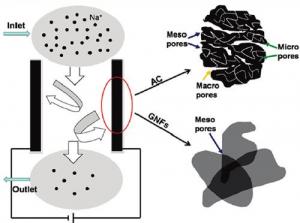Researchers from Australia and Shanghai have developed a Capacitive deionization (CDI) application that uses graphene-like nanoflakes as electrodes for capacitive deionization. Capacitive deionization (CDI) is a relatively new way to purify water. It is cost effective and energy efficient. The team believes that Graphene can be an excellent candidate for the electrode material for the CDI. This is not the first time we hear about Graphene being used to clear drinking water...

The basic concept behind CDI is to force charged ions toward oppositely polarized electrodes through imposing a direct electric field: brackish water flows between pairs of high surface area carbon electrodes that are held at a potential difference of about 1-2 volts. The ions and other charged particles, such as microorganisms, are attracted to and held on the electrode of opposite charge. The negative electrode attracts positively charged ions (cations) such as calcium, magnesium and sodium, while the positively charged electrode attracts negative ions (anions) such as chloride, nitrate, and silica (read more about how CDI technology works here).

